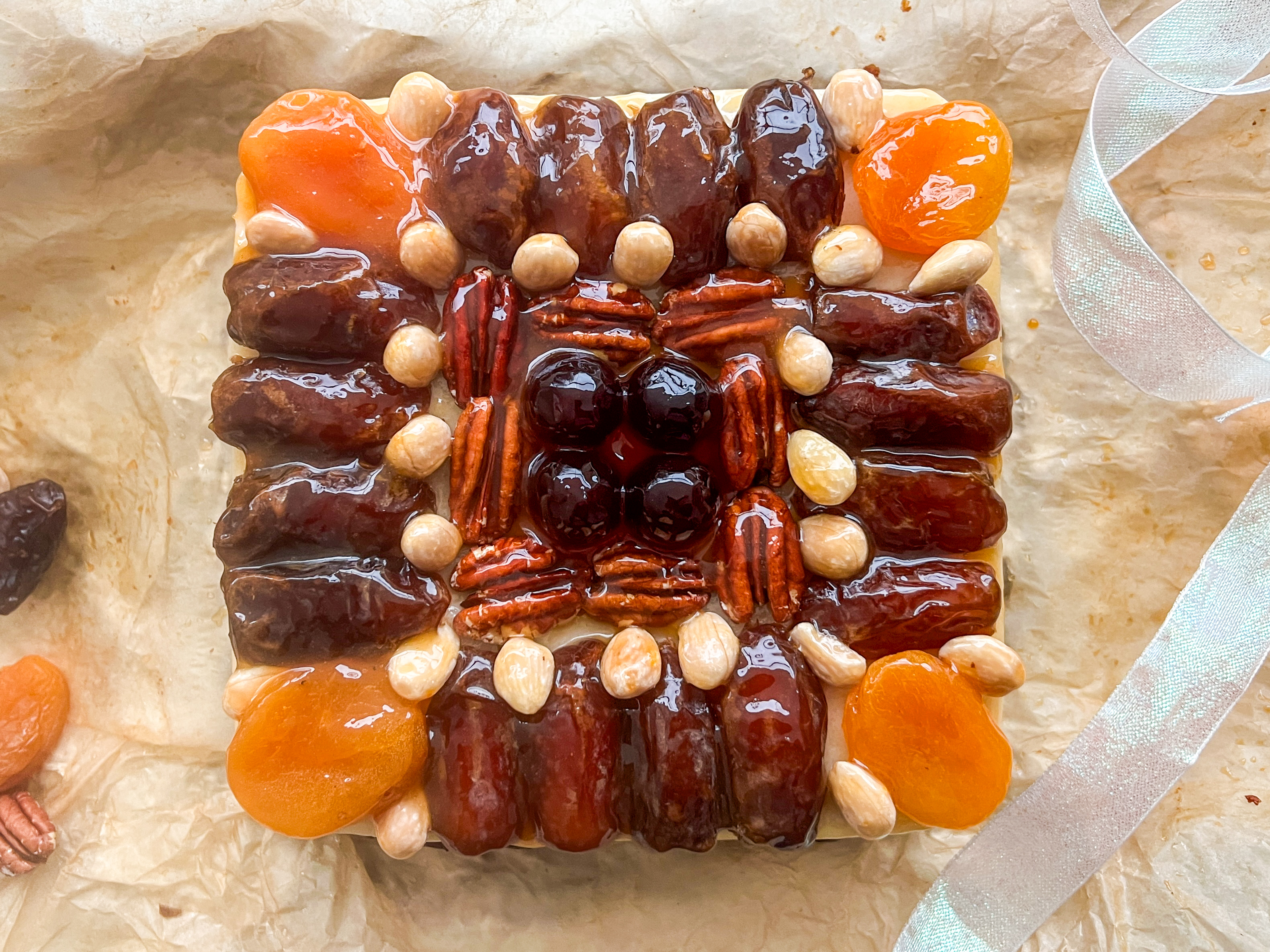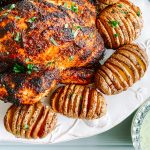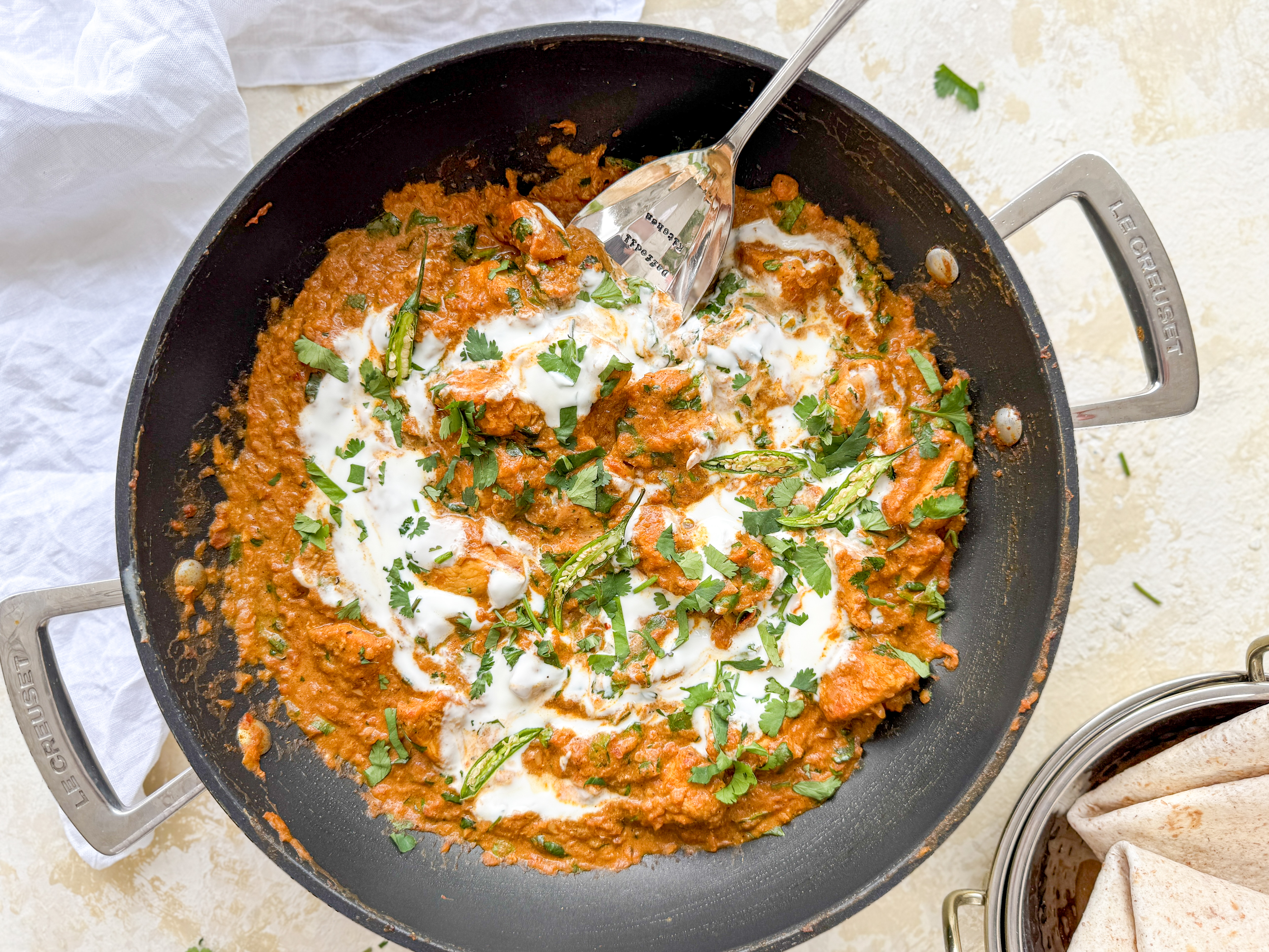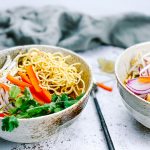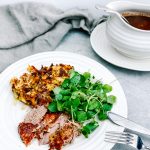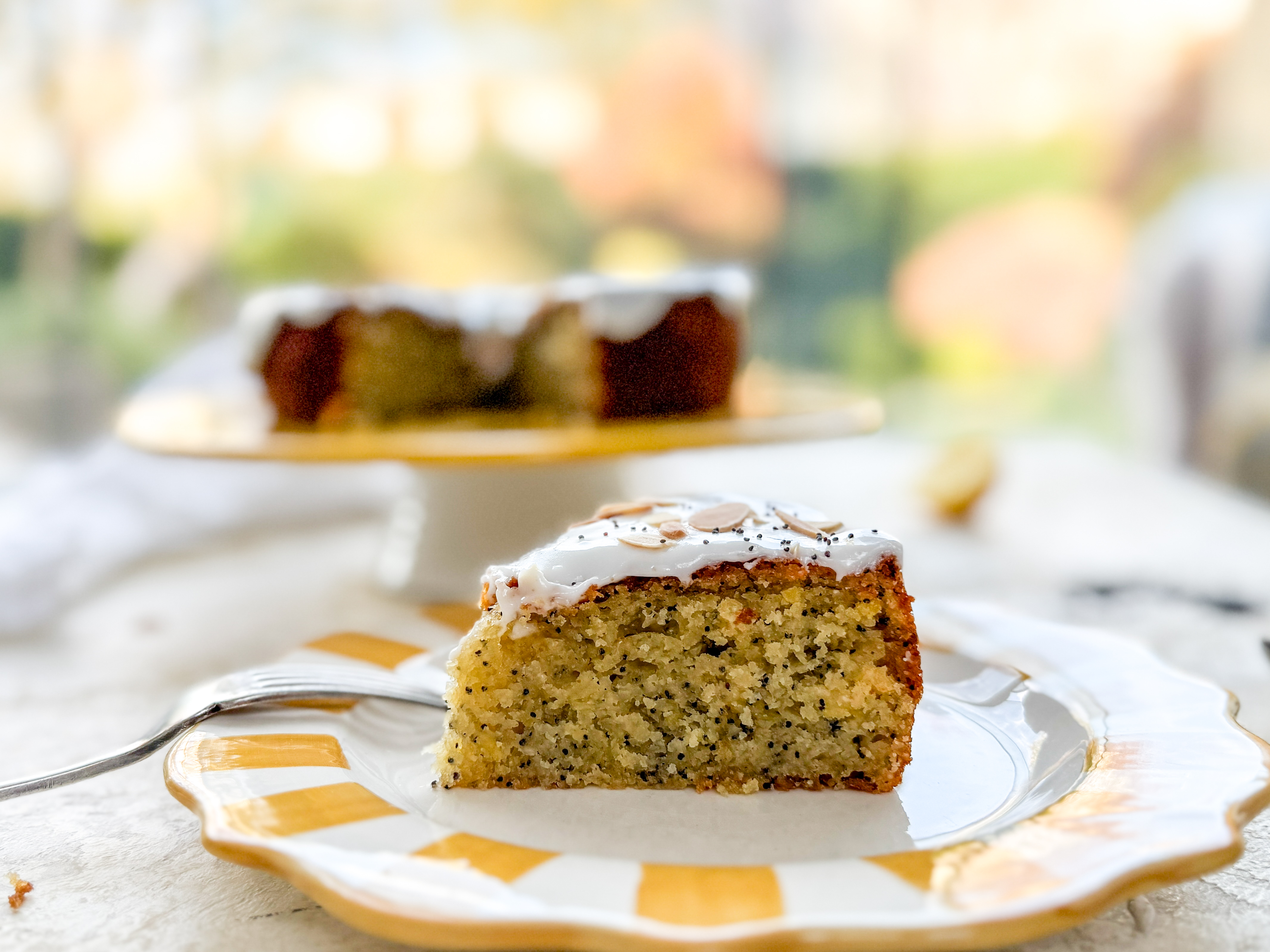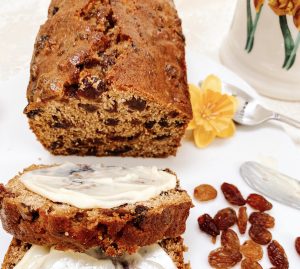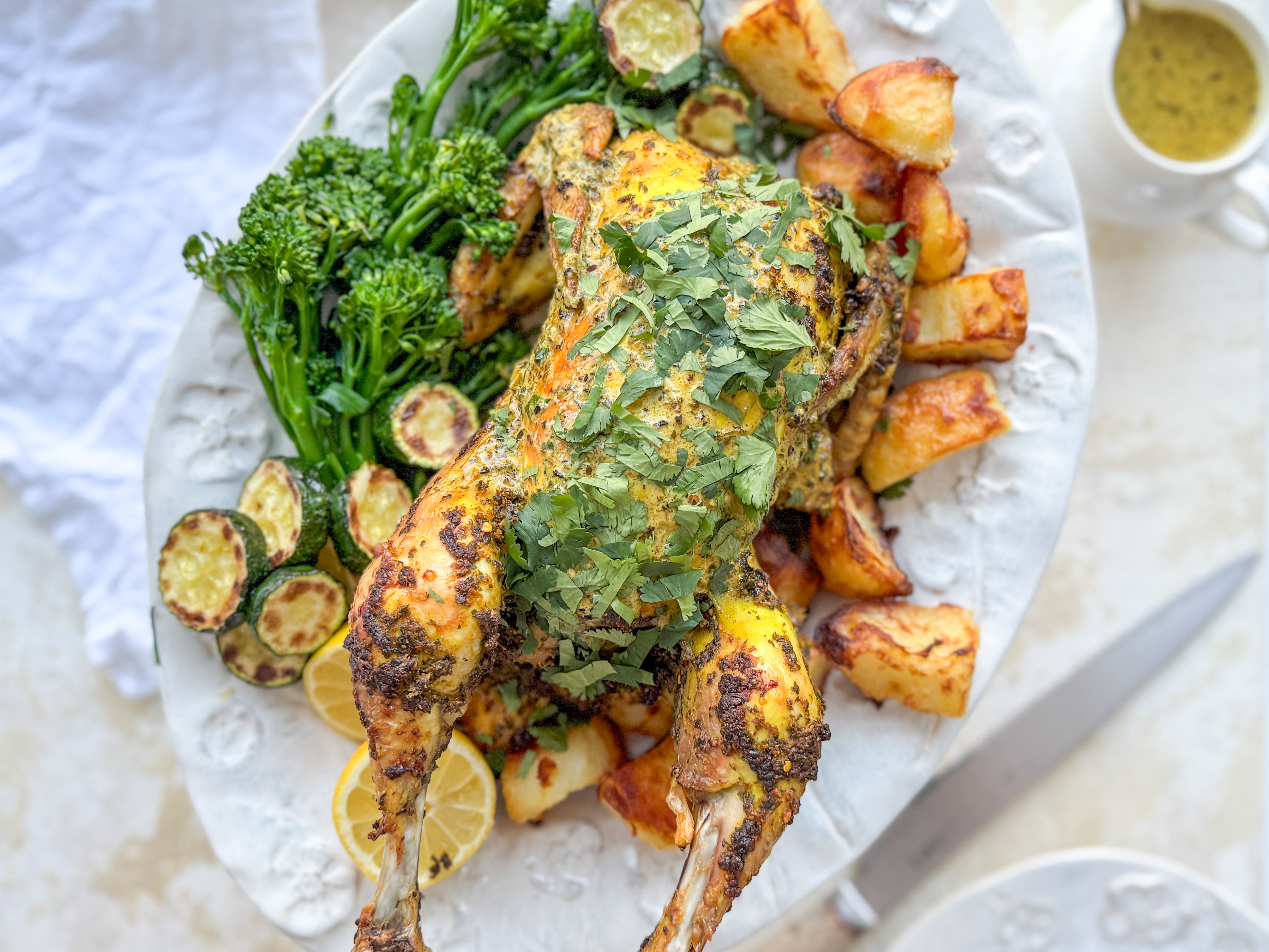
Wadadli Spiced Roast Chicken and Coconut Gravy
If you try no other new recipes this spring, I urge you to make this incredible roast chicken from Antigua. Spicy, herby, melt in the mouth roast chicken, with a crispy skin, is served with a coconut gravy and traditional roast chicken accompaniments. It is delicious with roast or mashed potatoes, and some steamed vegetables of your choice. Yorkshire puddings also work exceedingly well, or even some steamed rice.
Where does this recipe come from?
I came across this recipe in the February 2025 edition of Waitrose Food magazine. It is a recipe from chef and broadcaster, Andi Oliver. Andi is probably best known for her role in the television cooking show, Great British Menu. She describes this dish as being ‘love in action.’ She says that ‘this pot of food is all the love language we need; within it lie all the answers.’ I could not agree more; it is amazing!
Apparently the ancient Arawak name for Antigua is Wadadli; this delicious and comforting dish encompasses and makes the most of the island’s fragrant spices.
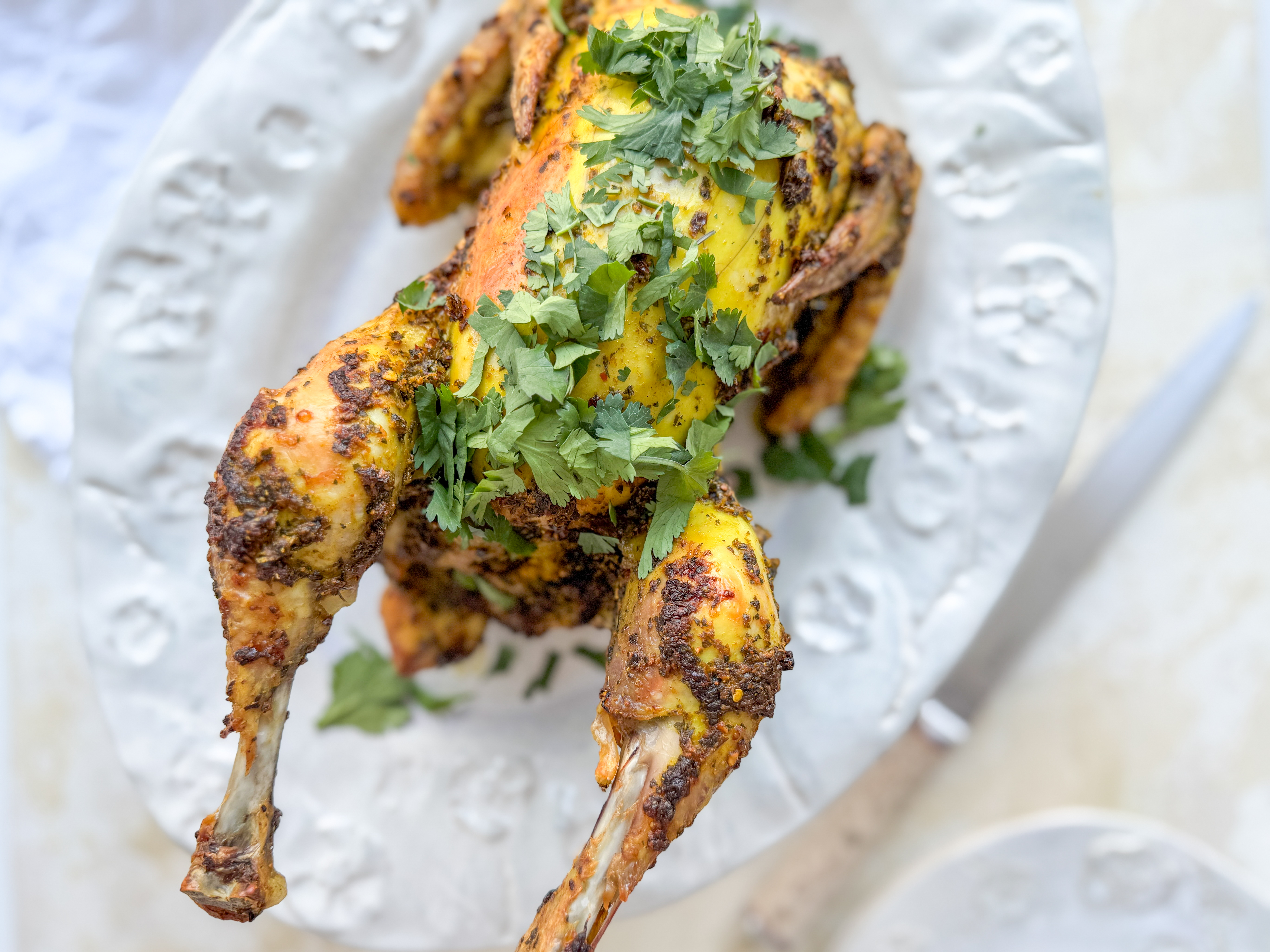
How to make Wadadli Spiced Roast Chicken and Coconut Gravy
Collect the ingredients together:
- whole chicken
- medium onion, halved
- garlic cloves
- can coconut milk
Spice oil –
- fresh ginger, peeled and roughly chopped
- garlic cloves, peeled
- spring onions, trimmed and roughly chopped
- fresh coriander leaves
- fresh flat leaf parsley
- ground turmeric
- ground cumin
- ground coriander
- dried chilli flakes
- fine salt
- olive oil
To serve –
- fresh chopped coriander and parsley
- roast or mashed potatoes
- steamed or roasted vegetables
- steamed rice
- Yorkshire puddings
- lemon wedges
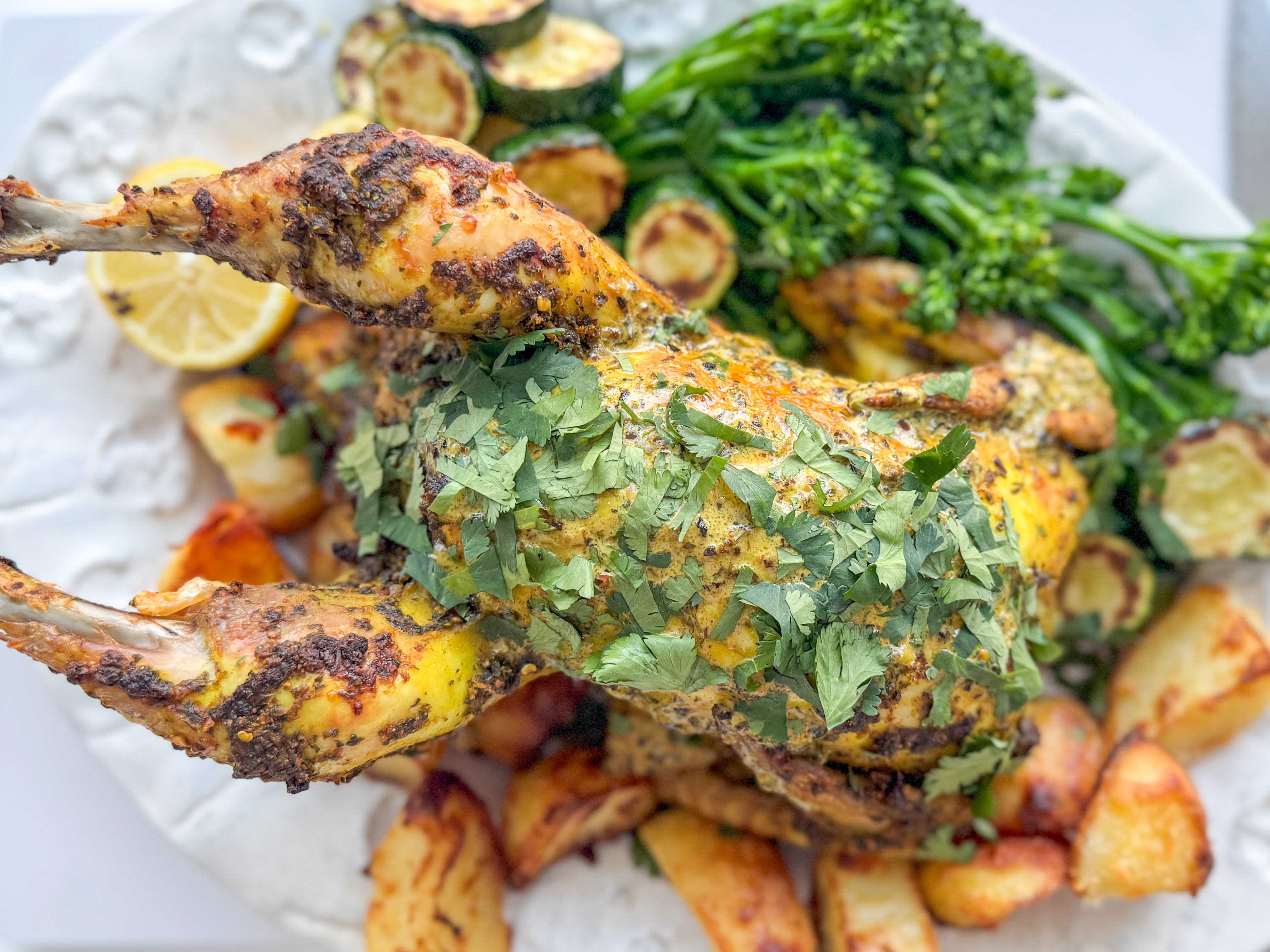
How to make this amazing roast chicken dish:
- Bring the chicken to room temperature. This will take between 30 minutes to an hour depending on the ambient temperature.
- Preheat oven to 170°C/325°F/Gas 3 (fan 150°C). You will also need a deep sided roasting tin, which you can also use on the hob.
- Make the spice oil – prepare the garlic, ginger and spring onions and blitz in a food processor until finely chopped.
- Next add the fresh herbs and pulse.
- Finally, add the spices and oil and blend thoroughly to a paste.
- Prepare and cook the chicken – stuff the onion and garlic inside the cavity of the chicken.
- Rub the paste all over the outside of the chicken thoroughly, ensuring it is well coated and in all the nooks and crannies.
- Place in a deep sided roasting tin, which you can also use on the hob, and cover with kitchen foil. Cook in the centre of a pre-heated oven for 1 hour.
- Remove from the oven and turn the heat up to 220°C/425°F/Gas 7 (fan 200°C).
- Remove the foil, baste the chicken and return to the oven and continue to cook for 20 – 40 minutes, or until the chicken is cooked. To check if it is cooked, pull the leg away from the bird slightly and skewer into the breast flesh behind the leg. Any juices coming out of the bird should be clear and the meat should be opaque. If you see any pinkness or blood, cook for a further 10 – 15 minutes, or until cooked. If you use a meat thermometer, the internal temperature of the meat should read 75°C or 165°F.
- Make the coconut gravy – remove the chicken from the pan, scraping any thick areas of paste on the chicken into the pan. Allow the chicken to rest for 10 – 15 minutes before serving.
- Meanwhile, add the coconut milk to the pan and bring to a gentle simmer for 7 – 10 minutes to thicken and allow the flavours to develop and merge. Stir regularly, taste and adjust seasoning, if necessary.
- Garnish the roast chicken with some of the coconut gravy, some chopped fresh herbs and serve with the remaining gravy. Serve according to taste. Traditional roast or mashed potatoes and steamed vegetables make excellent accompaniments, as do Yorkshire puddings or some steamed rice. I also enjoy a spritz of lemon juice.
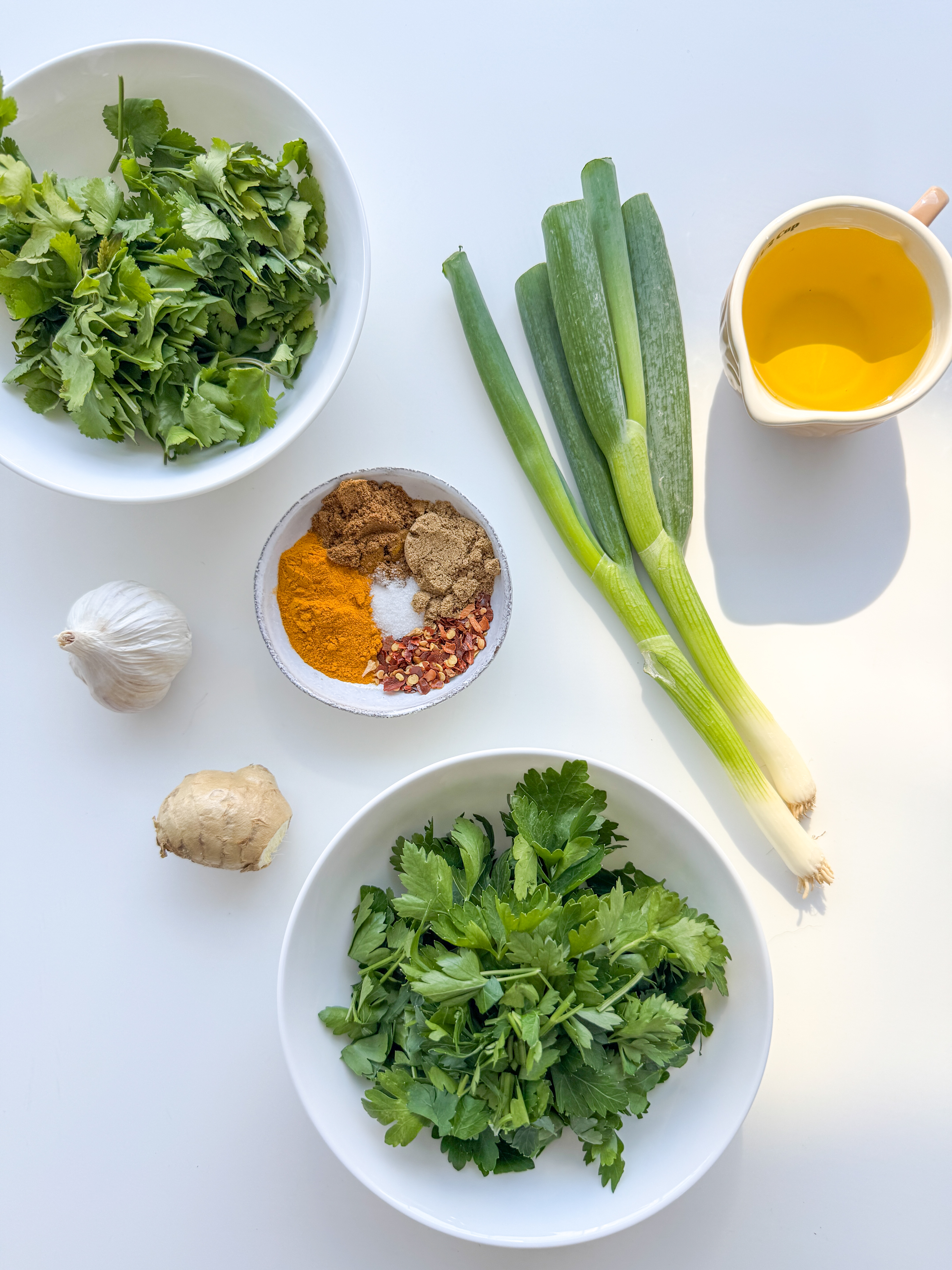
Spice oil ingredients 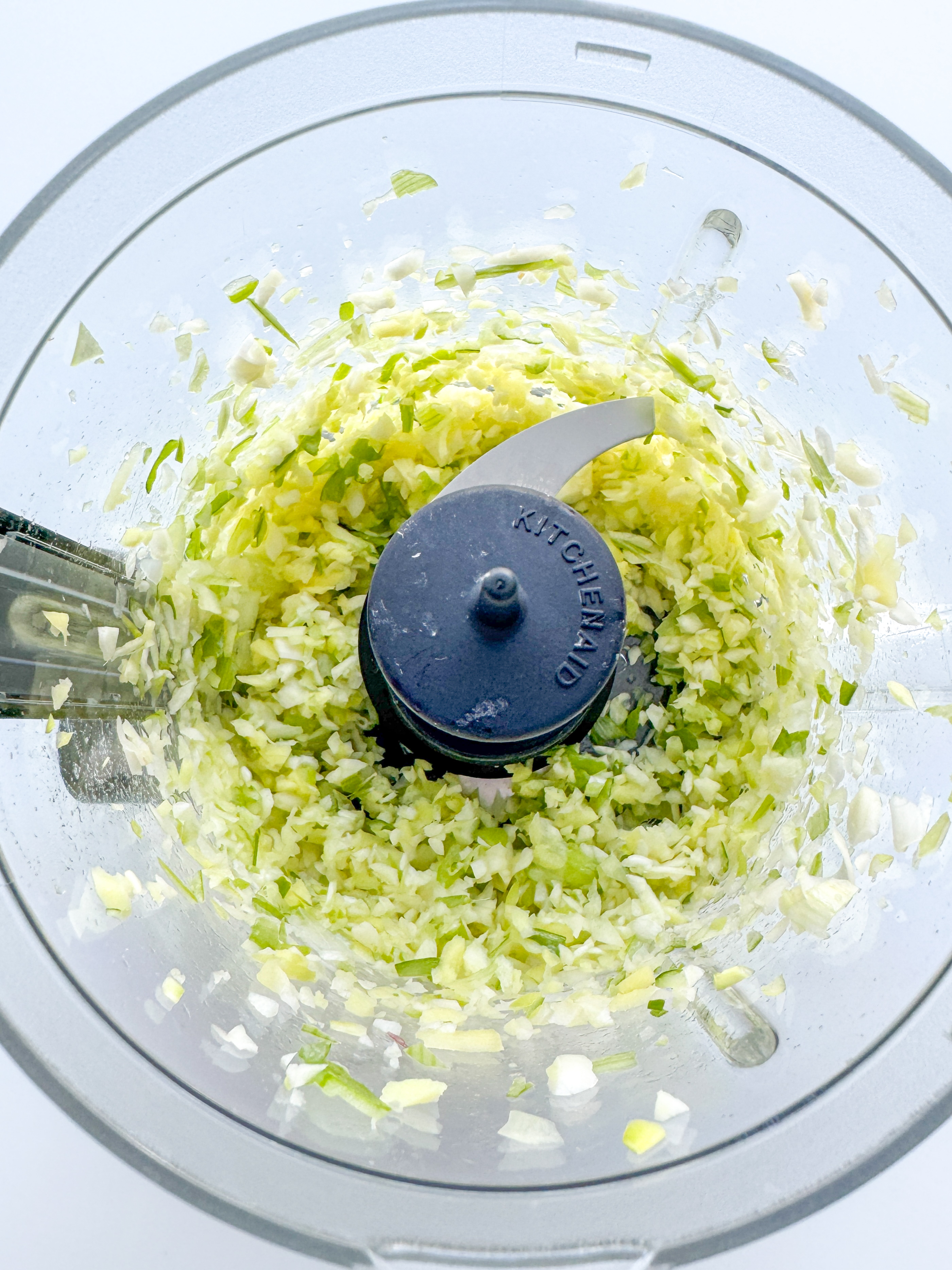
3 Garlic, ginger, onion 
4 Herbs 
5 Spices, oil 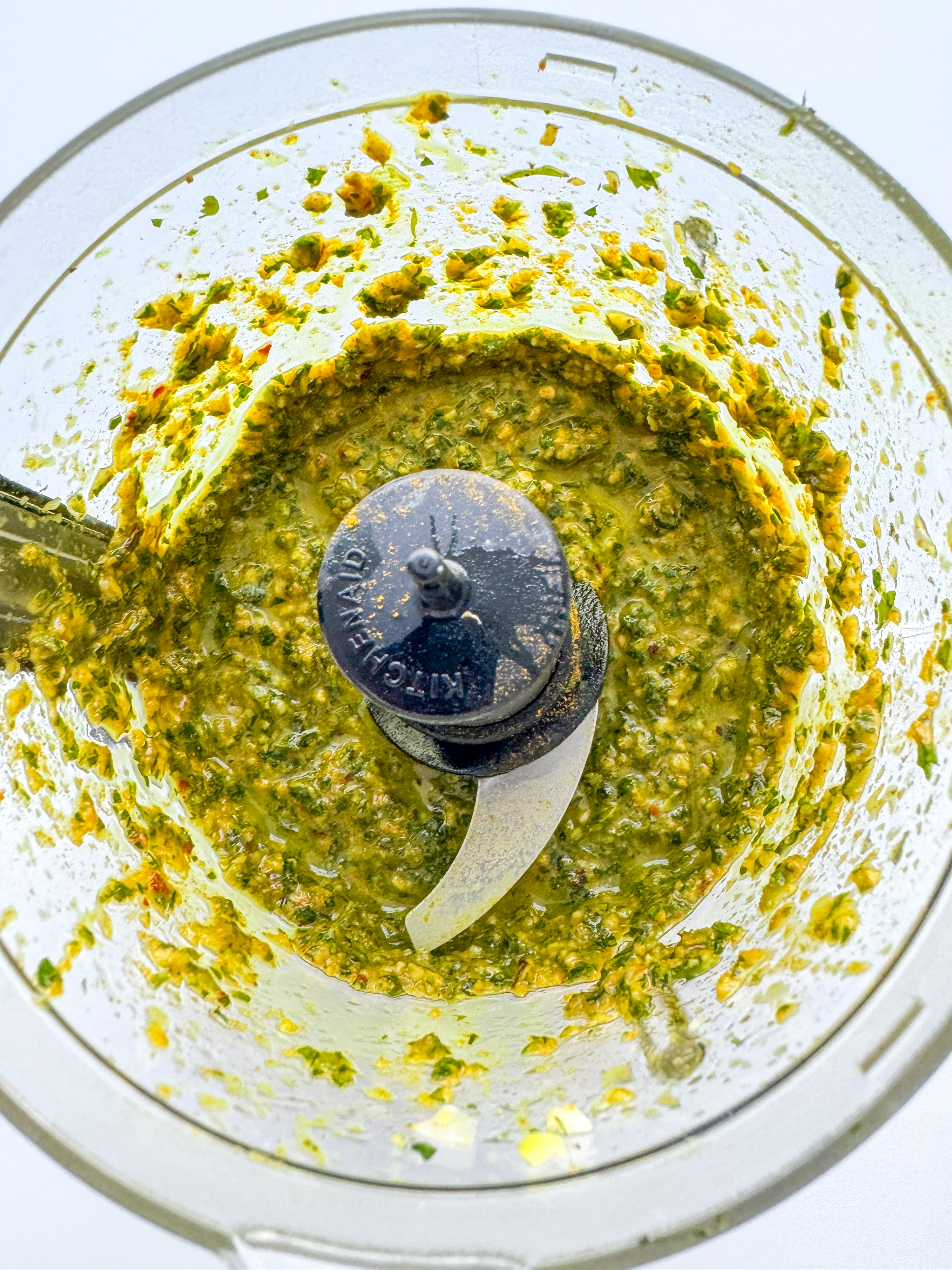
Paste 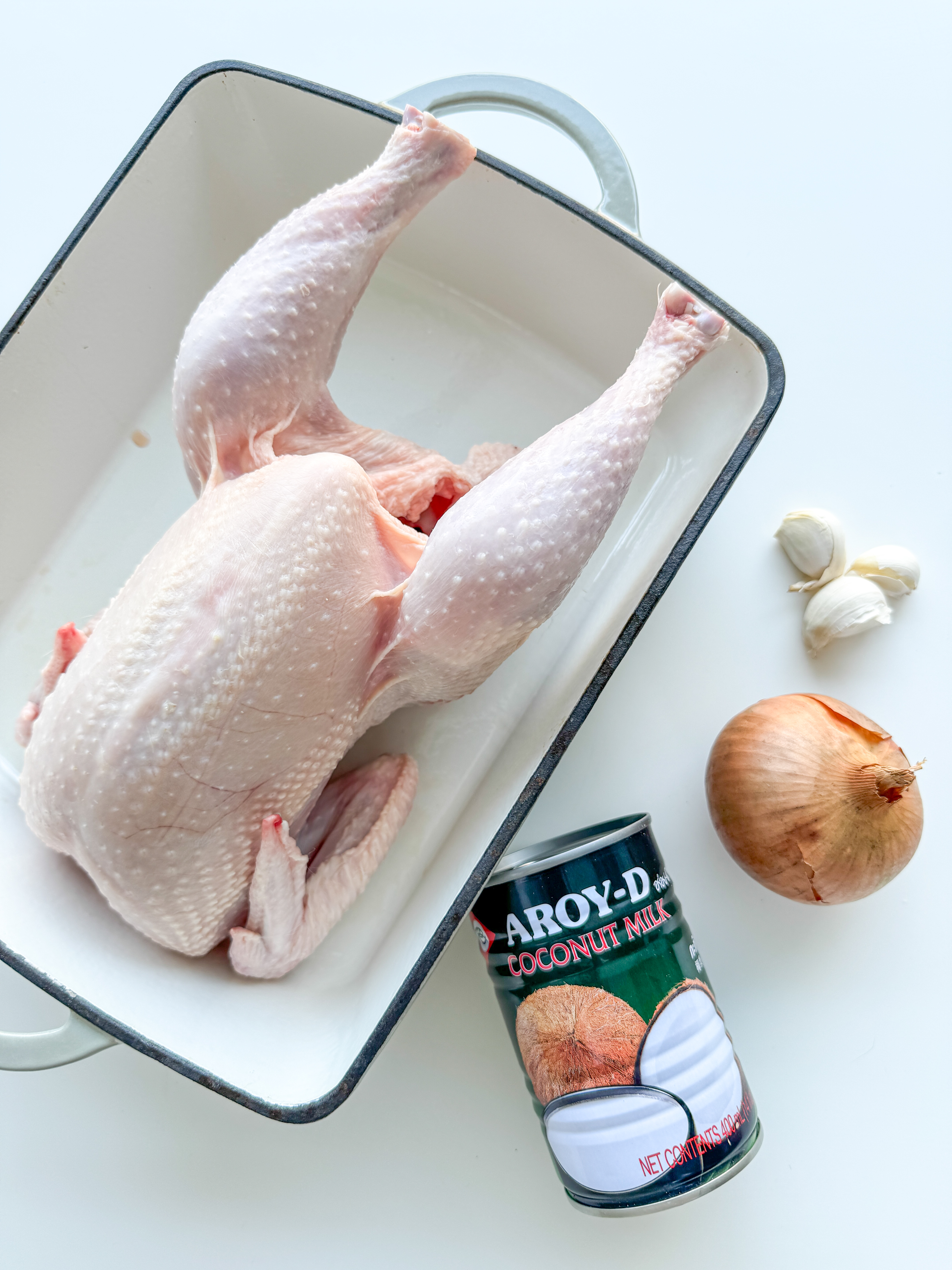
Remaining ingredients 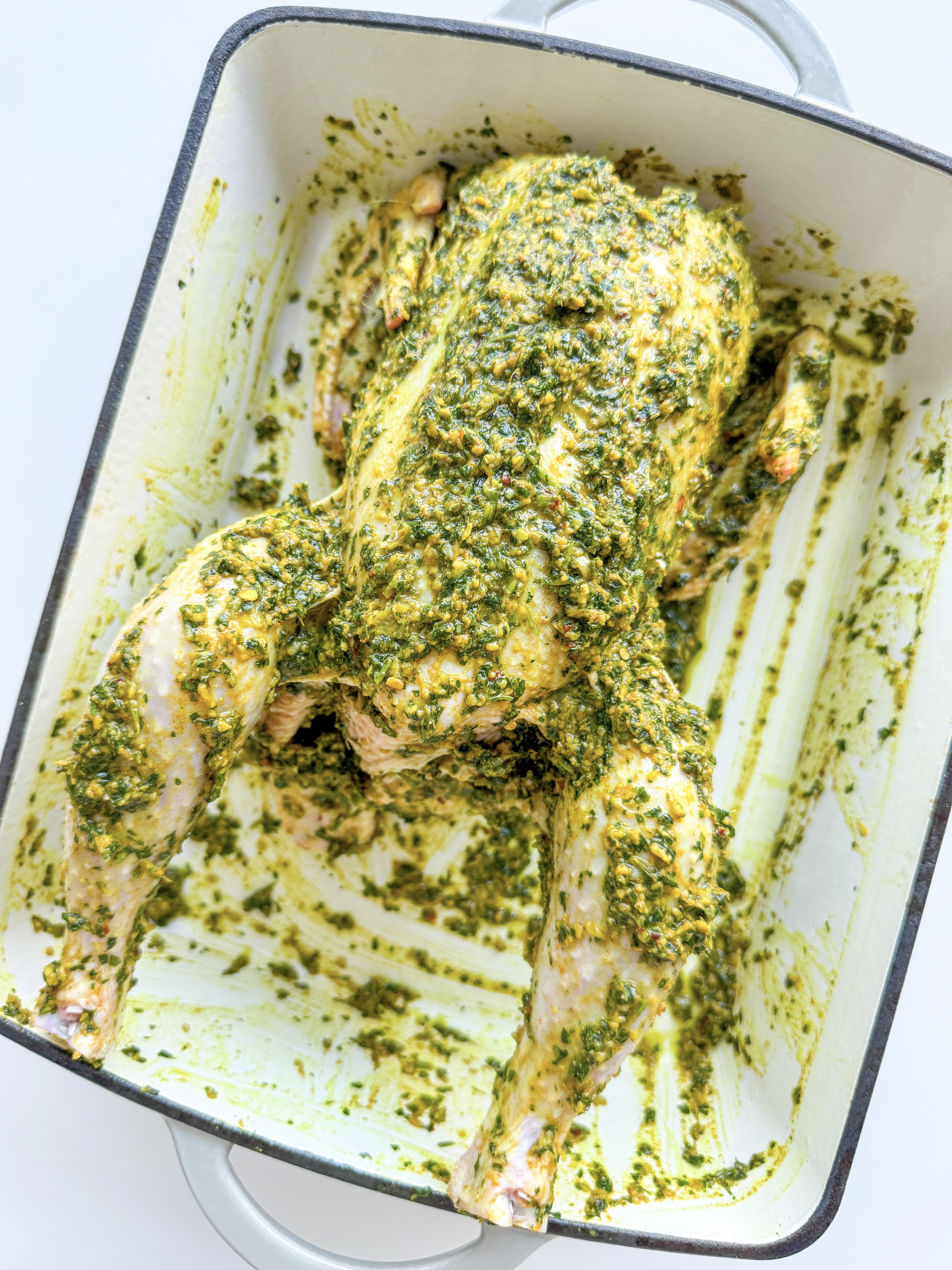
7 Rub paste 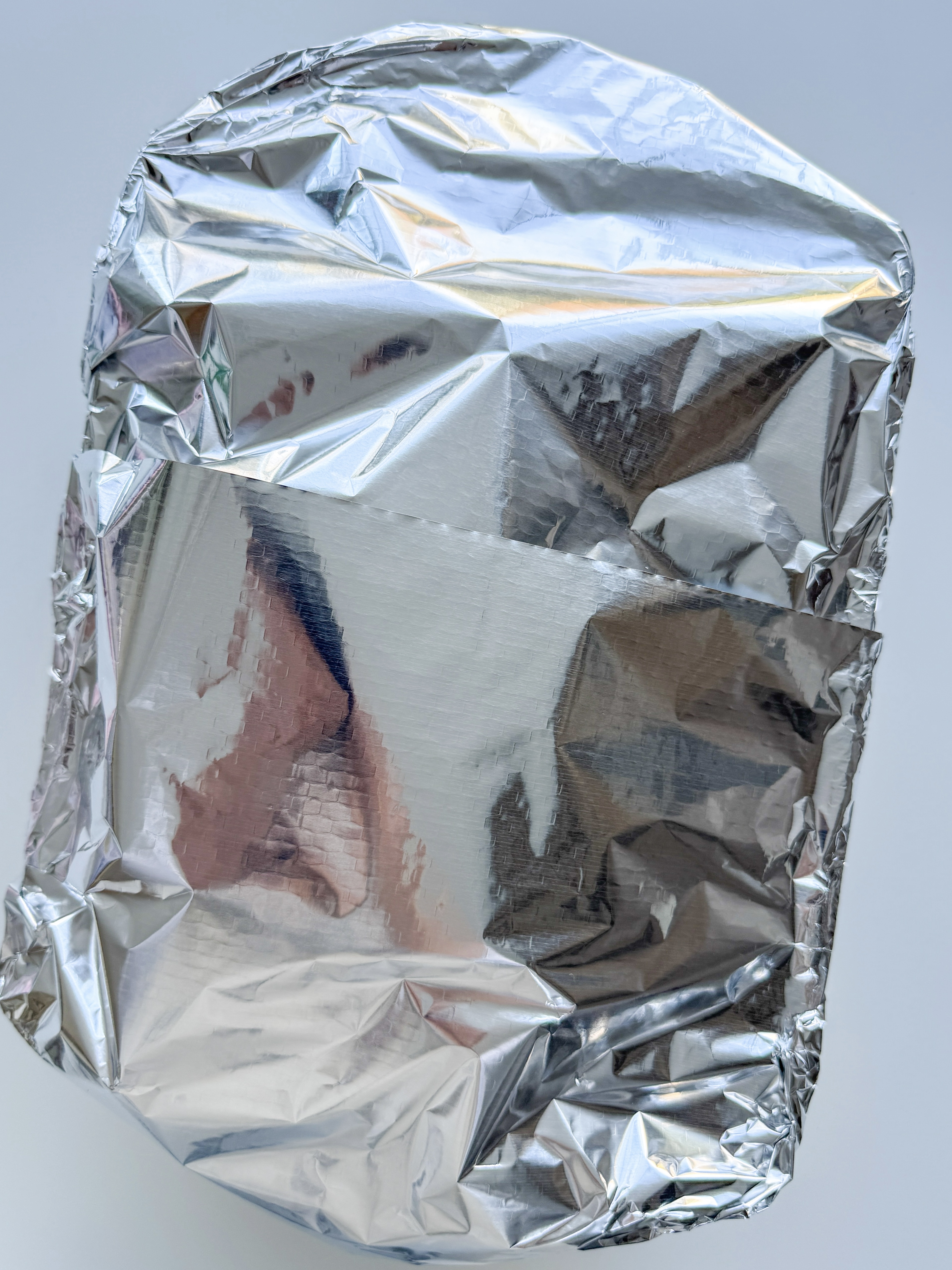
8 Cover, cook 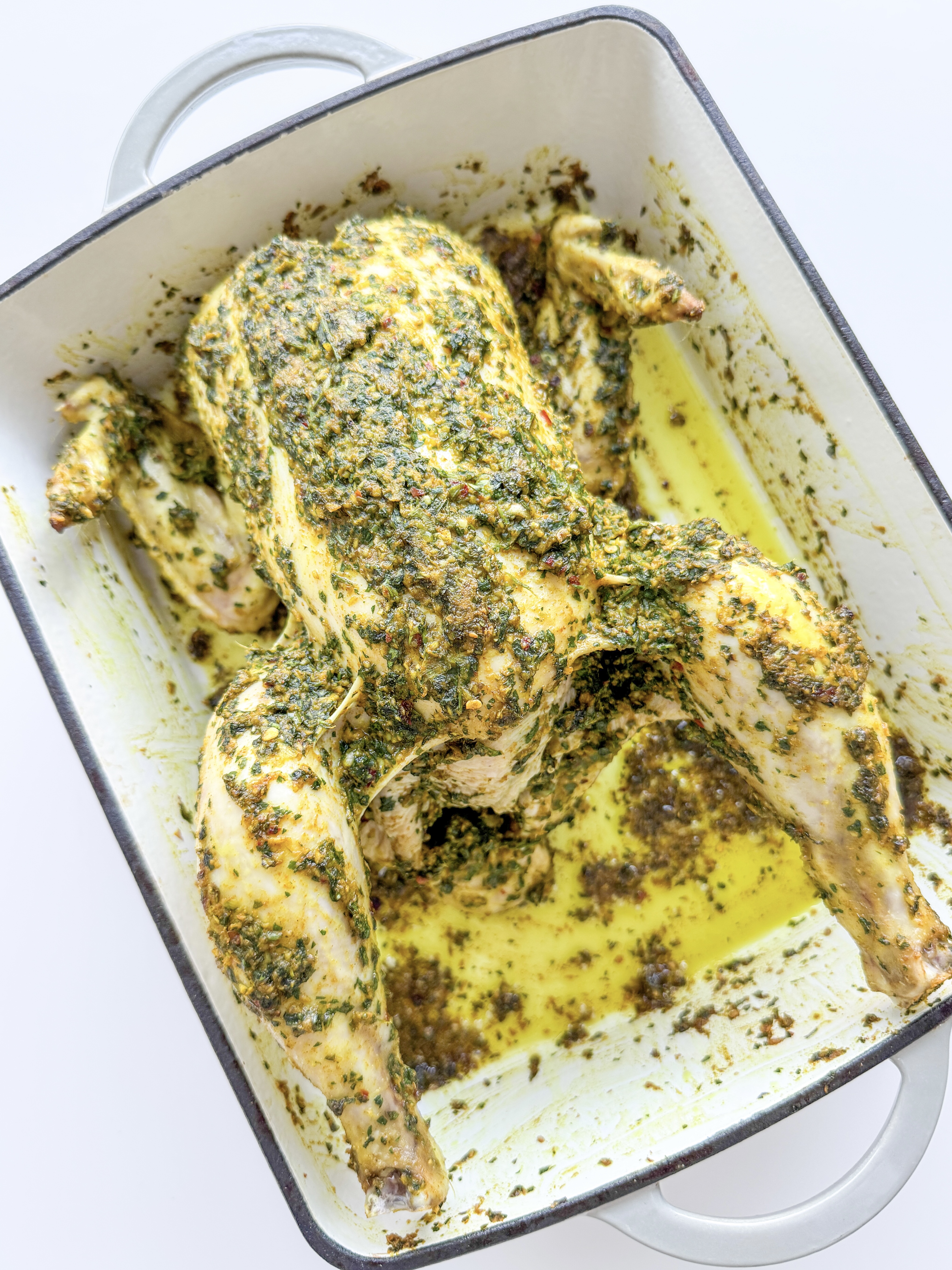
Cook 1 hour 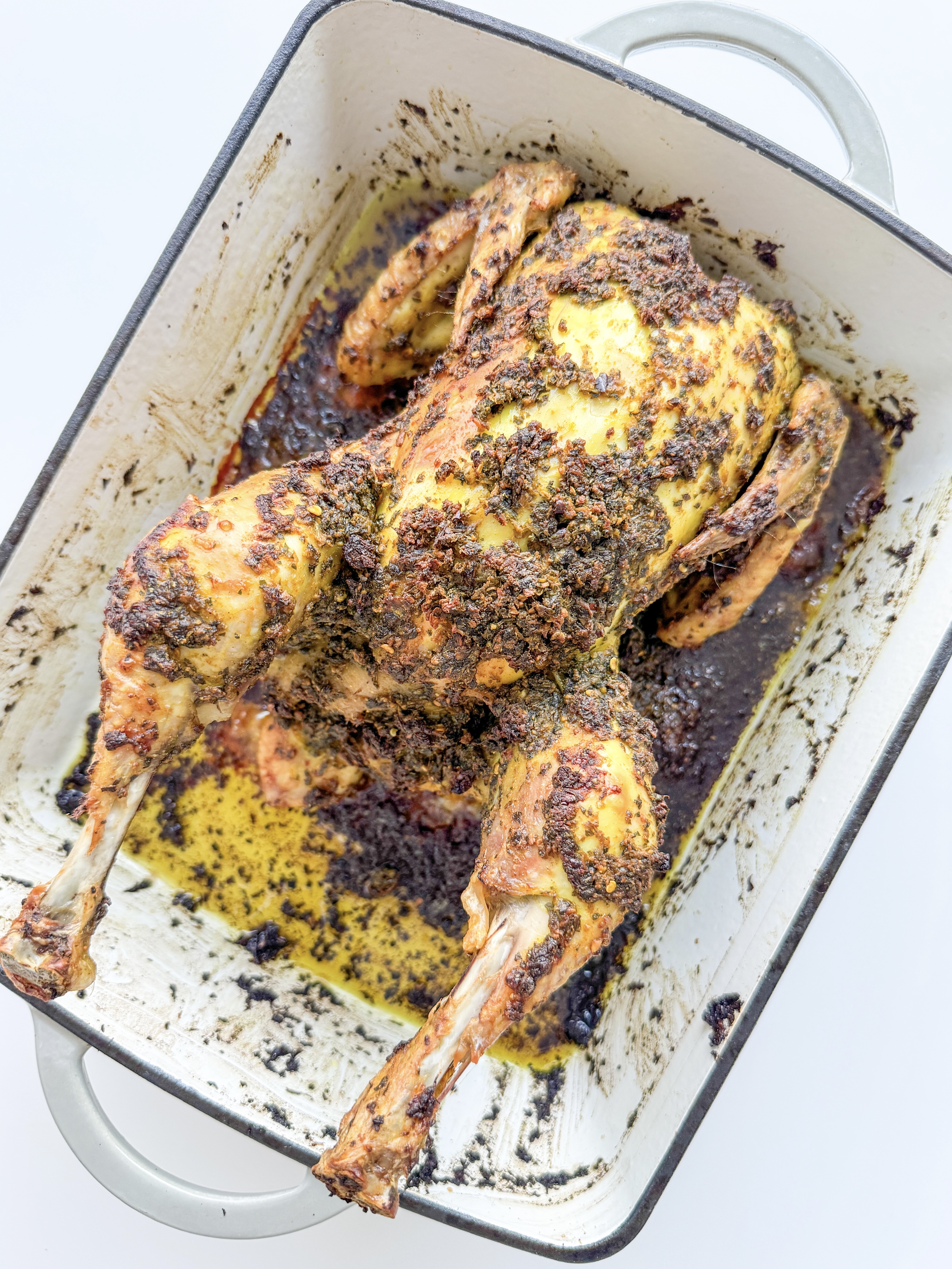
10 Cook, no cover 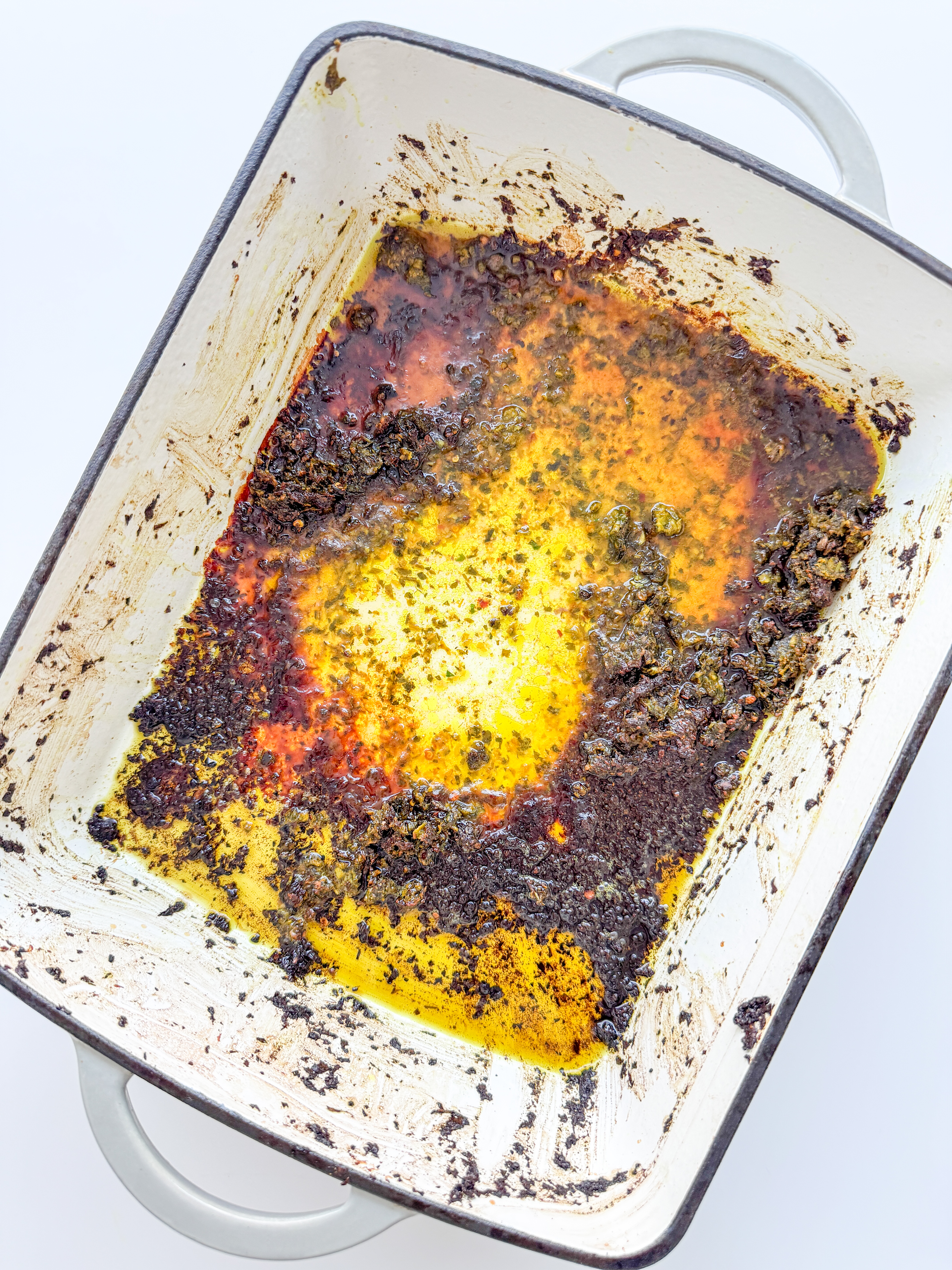
11 Remove chicken 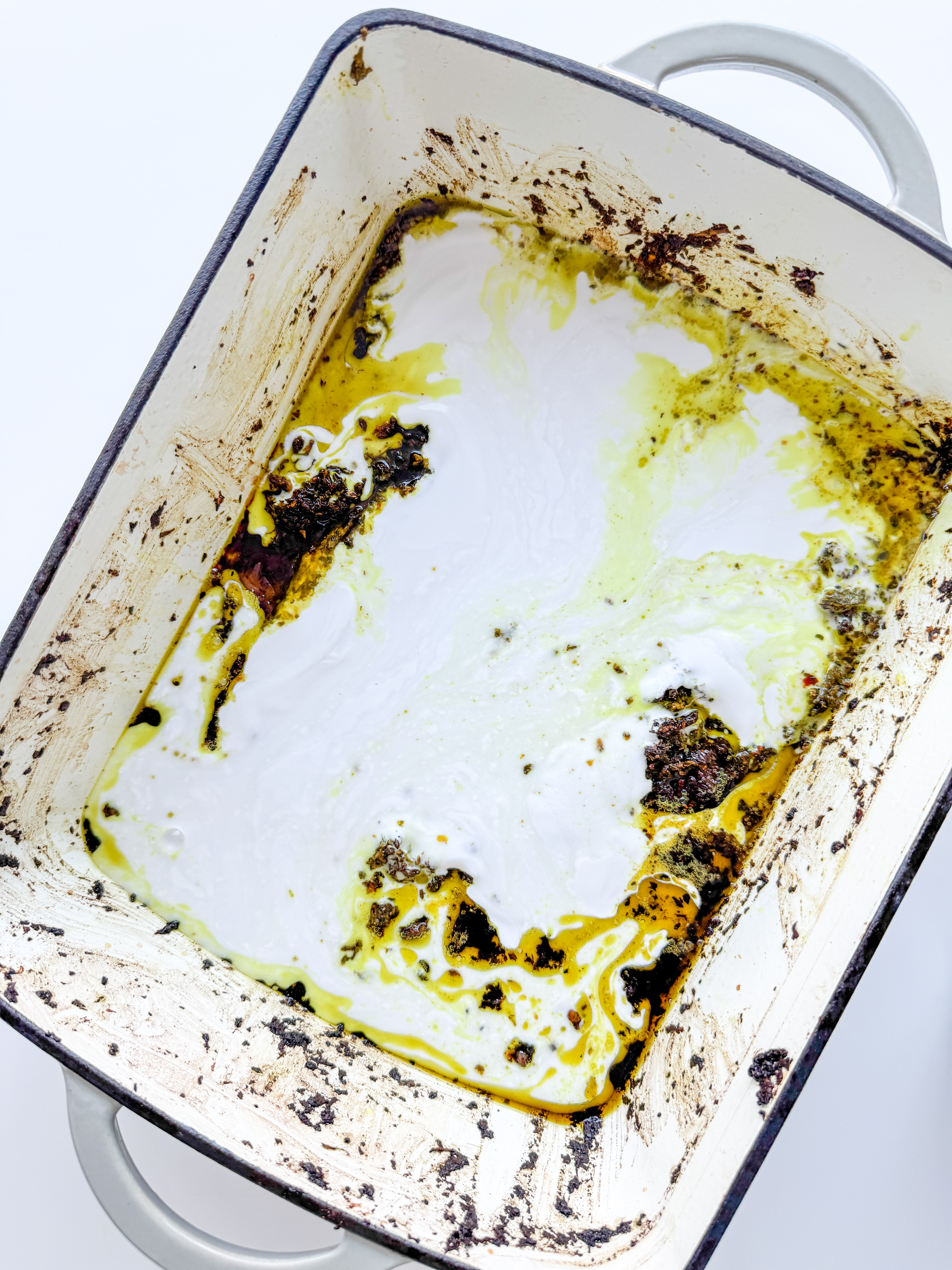
12 Coconut milk, cook 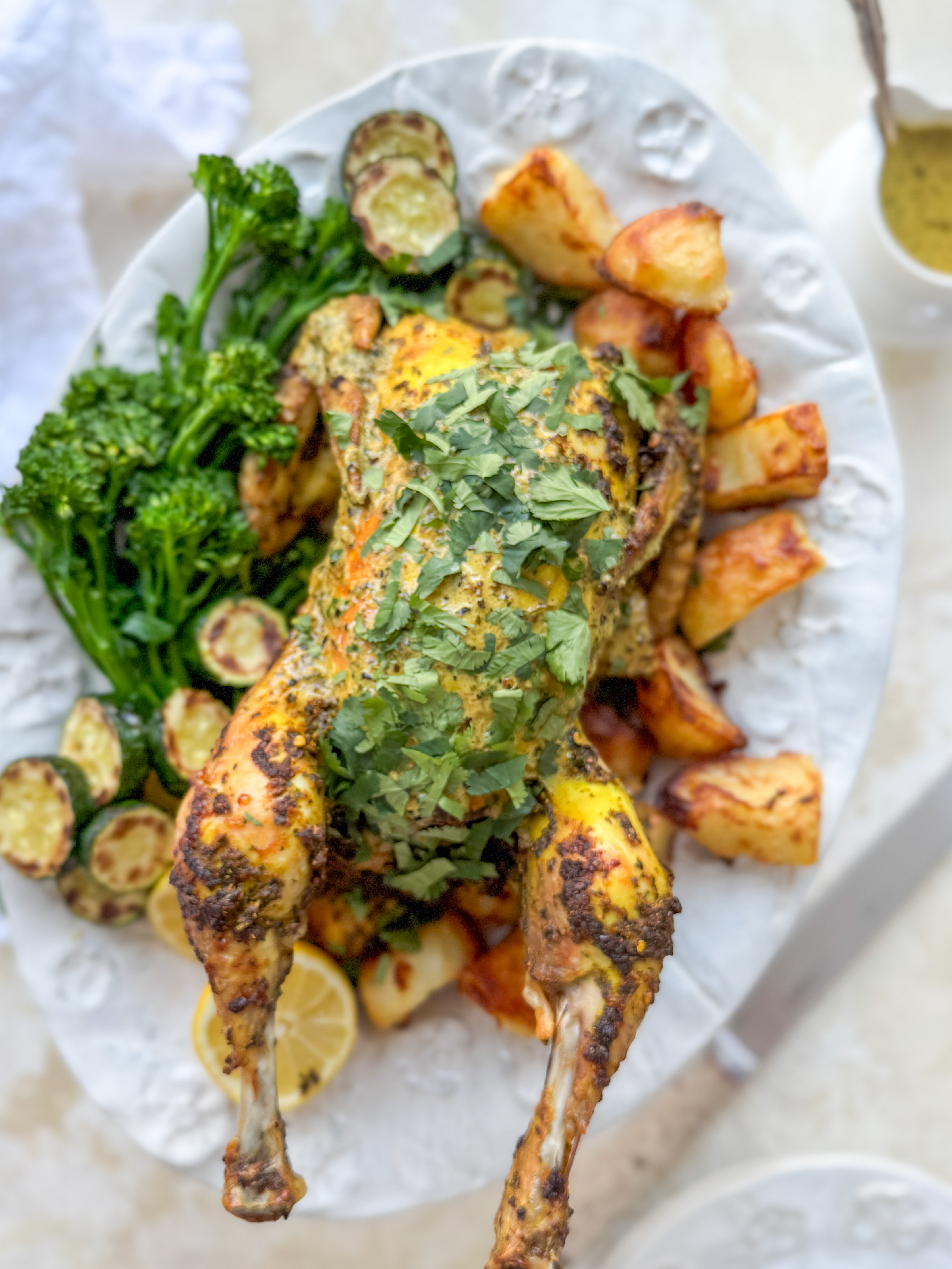
Serve
Is this recipe exactly the same as the original?
In short, no. This recipe is very slightly adapted from the original. The changes I made include:
- Andi adds a sprig of fresh thyme in the chicken with the garlic and onion. I didn’t have any so simply omitted it.
- She also adds 25g creamed coconut to the sauce. I buy coconut milk from my local Asian food shop. It is rich and creamy ad I find you do not need the creamed coconut. However, some of the supermarket coconut milks, are much thinner so if using, a can of this, add the coconut cream as well.
- I love ginger, so I increased the quantity from 5g to15g.
- I use dried chilli flakes rather than fresh chillies. If using fresh chillies, the original recipes states that you need 2 – 3 mixed Thai chillies.
- In relation to the fresh herbs, the original recipe uses ¼ of a 25g packet of coriander and ¼ of a 25g packet of parsley. I clearly should have gone to Specsavers – I added 20g of both herbs. However, I loved this dish so much the first time I made it, that I have continued to use the increased quantities of fresh herbs.
- I use ¾ teaspoon salt, rather than 1 teaspoon. Don’t forget to taste and adjust the seasoning of the gravy, if necessary. It may well need a further ⅛ – ¼ teaspoon of fine salt.
- I use olive oil, rather than rapeseed oil. I also use 100ml, rather than 80ml, as stated in the original recipe. Because I increased the amount of herbs, additional oil is needed to make a soft enough paste.
Why should meat be at room temperature when cooked?
When you cook meat, the muscles in the flesh contract and tighten when heated. The colder the muscles the more they will contract; this means it is harder for the heat to distribute evenly. By letting the meat come to room temperature before you cook it, the meat will cook more evenly and when cooked, it will be juicier. It can take between 30 – 60 minutes for fridge cold meat to reach room temperature, depending on its size and the ambient room temperature.
Why do you need time to rest the meat after cooking?
As the muscles of the meat contract and tighten when cooked, the juices are forced toward the surface of the meat and some will evaporate. (Which is why overcooked meat is dry.) Allowing the meat to rest after you have removed the heat source, means the muscles will relax and the juices can re-distribute throughout the meat. If you cut it immediately, you are in danger of losing some of these juices; your chicken may then be dry and the flavour from those gorgeous juices will be lost.
Made this recipe?
If you make this recipe, do please tag me on instagram @daffodil_kitchen. You could also leave a comment in the box directly below the recipe.

Wadadli Spiced Roast Chicken and Coconut Gravy
If you try no other new recipes this spring, I urge you to make this incredible roast chicken from Antigua. Spicy, herby, melt in the mouth roast chicken, with a crispy skin, is served with a coconut gravy and traditional roast chicken accompaniments. It is delicious with roast or mashed potatoes, and some steamed vegetables of your choice. Yorkshire puddings also work exceedingly well, or even some steamed rice.
Serves 3 – 4
Ingredients
- 1.5 – 2kg whole chicken
- 1 medium onion, halved
- 3 cloves of garlic
- 400ml can good quality coconut milk
Spice oil:
- 15g fresh ginger, peeled and roughly chopped
- 35g/10 cloves of garlic, peeled
- 2 spring onions, trimmed and roughly chopped
- 20g fresh coriander leaves
- 20g fresh flat leaf parsley
- 1½ teaspoons ground turmeric
- 1 teaspoon ground cumin
- 1 teaspoon ground coriander
- ½ – 1 teaspoon dried chilli flakes (I use ¾ teaspoon)
- ¾ – 1 teaspoon fine salt, to taste
- 100ml olive oil
To serve:
- fresh chopped coriander and parsley
- roast or mashed potatoes
- steamed or roasted vegetables
- steamed rice
- Yorkshire puddings
- lemon wedges
Instructions
-
Collect together your equipment (see Recipe Notes below) and ingredients.
-
Bring the chicken to room temperature. This will take between 30 minutes to an hour depending on the ambient temperature.
-
Preheat oven to 170°C/325°F/Gas 3 (fan 150°C). You will also need a deep sided roasting tin, which you can also use on the hob.
-
Make the spice oil – prepare the garlic, ginger and spring onions and blitz in a food processor until finely chopped.
-
Next add the fresh herbs and pulse.
-
Finally, add the spices and oil and blend thoroughly to a paste.
-
Prepare and cook the chicken – stuff the onion and garlic inside the cavity of the chicken.
-
Rub the paste all over the outside of the chicken thoroughly, ensuring it is well coated and in all the nooks and crannies.
-
Place in a deep sided roasting tin, which you can also use on the hob, and cover with kitchen foil. Cook in the centre of a pre-heated oven for 1 hour.
-
Remove from the oven and turn the heat up to 220°C/425°F/Gas 7 (fan 200°C).
-
Remove the foil, baste the chicken and return to the oven and continue to cook for 20 – 40 minutes, or until the chicken is cooked. To check if it is cooked, pull the leg away from the bird slightly and skewer into the breast flesh behind the leg. Any juices coming out of the bird should be clear and the meat should be opaque. If you see any pinkness or blood, cook for a further 10 – 15 minutes, or until cooked. If you use a meat thermometer, the internal temperature of the meat should read 75°C or 165°F.
-
Make the coconut gravy – remove the chicken from the pan, scraping any thick areas of paste on the chicken into the pan. Allow the chicken to rest for 10 – 15 minutes before serving.
-
Meanwhile, add the coconut milk to the pan and bring to a gentle simmer for 7 – 10 minutes to thicken and allow the flavours to develop and merge. Stir regularly, taste and adjust seasoning, if necessary.
-
Garnish the roast chicken with some of the coconut gravy, some chopped fresh herbs and serve with the remaining gravy. Serve according to taste. Traditional roast or mashed potatoes and steamed vegetables make excellent accompaniments, as do Yorkshire puddings or some steamed rice. I also enjoy a spritz of lemon juice.
Recipe Notes
Equipment:
- kitchen scales and measuring spoons
- chopping board and knife
- food processor
- deep sided roasting tin/baking dish
Where does this recipe come from?
I came across this recipe in the February 2025 edition of Waitrose Food magazine. It is a recipe from chef and broadcaster, Andi Oliver. Andi is probably best known for her role in the television cooking show, Great British Menu. She describes this dish as being ‘love in action.’ She says that ‘this pot of food is all the love language we need; within it lie all the answers.’ I could not agree more; it is amazing!
Apparently the ancient Arawak name for Antigua is Wadadli, and this delicious and comforting dish encompasses and makes the most of the island’s fragrant spices.
Is this recipe exactly the same as the original?
In short, no. This recipe is very slightly adapted from the original. The changes I made include:
- Andi adds a sprig of fresh thyme in the chicken with the garlic and onion. I didn’t have any so simply omitted it.
- She also adds 25g creamed coconut to the sauce. I buy coconut milk from my local Asian food shop. It is rich and creamy; however, some of the supermarket coconut milks, are much thinner. If using a supermarket milk, add the coconut cream as well. With a good quality coconut milk, I find you do not need the creamed coconut.
- I love ginger, so I increased the quantity from 5g to15g.
- I use dried chilli flakes rather than fresh chillies. If using fresh chillies, the original recipes states that you need 2 – 3 mixed Thai chillies.
- Re the fresh herbs, the original recipe uses ¼ of a packet of coriander and ¼ of a packet of parsley. I clearly should have gone to Specsavers – I added 20g of both herbs. However, I loved this dish so much the first time I made it, that I have continued to use the increased quantities of fresh herbs.
- I used ¾ teaspoon salt, rather than 1 teaspoon. Don’t forget to taste and adjust the seasoning of the gravy, if necessary. It may well need a further ⅛ – ¼ teaspoon of fine salt.
- I use olive oil, rather than rapeseed oil. I also use 100ml, rather than 80ml as stated in the recipe. Because I increased the amount of herbs, additional oil is needed to make a paste.
More from my site
You May Also Like
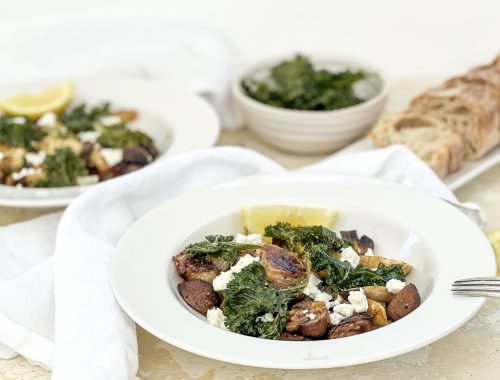
Roast Kohlrabi, King Oyster Mushrooms and Artichokes, served with Crispy Kale and Crumbled Feta, drizzled with a Chilli, Garlic, Brown Butter
11th August 2022
Warm Salad of Sweetcorn, Red Pepper, Black Beans and Coriander with Chilli and Lime
2nd June 2022